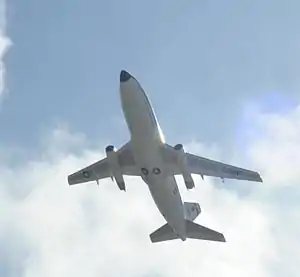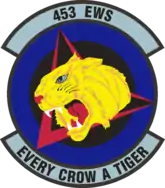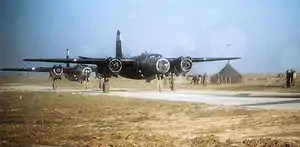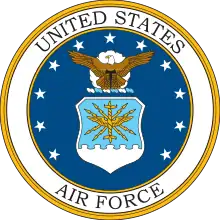453d Electronic Warfare Squadron
The 453d Electronic Warfare Squadron is a United States Air Force unit. It is assigned to the 53d Wing and is stationed at Lackland Air Force Base, Texas.
| 453d Electronic Warfare Squadron | |
|---|---|
 Boeing T-43 as flown by the squadron in the 1990s | |
| Active | 1942-1945, 1949-1951, 1955-1957, 1973-1993, c. 2000–present |
| Country | |
| Branch | |
| Role | Electronic Warfare |
| Part of | Air Combat Command |
| Motto(s) | Every Crow a Tiger |
| Decorations | Distinguished Unit Citation[1]Air Force Outstanding Unit Award[2] |
| Insignia | |
| 453d Electronic Warfare Squadron emblem |  |
| 453d Fighter-Bomber Squadron emblem (approved 1 February 1957)[1] |  |
| 453d Bombardment Squadron emblem[3] |  |
Overview
The 453d provides electronic warfare (EW) support to Department of Defense and coalition warfighters. It provides EW support through four flights, operating to provide radio frequency (RF) and other EW analyses and create a realistic training environment for the warfighter. Its products and services are utilized in a variety of areas, including mission planning, training, and exercises.
- The Flagging Analysis flight provides tactical comparison of current expectations to current reality to prepare warfighters to deploy and operate. It monitors worldwide threat environment to detect and identify of new or changed threat radars that may impact the performance of aircraft EW systems.
- The Operations flight analyses active and passive RF-based Sensor, EW & Command, Control & Communications and Intelligence Surveillance & Reconnaissance systems' performance in support of operational, acquisition, and training activities. Its Improved Many-on-Many (IMOM) family of analysis tools support mission planners with comprehensive EW & Command, Control & Communications and Intelligence Surveillance & Reconnaissance analyses, including radar detection, threat engagement, communications & jamming, Intelligence Surveillance & Reconnaissance collection, psychological operations broadcast, and passive detection capabilities. Additionally, the flight provides computer-based EW target sets and various other modeling and simulation-based training scenarios.
- In 2015, The squadron's Data flight became a part of the 57th Intelligence Squadron. It developed and maintained the Combat Support Database, Blue Airborne Target Signatures Database, US Electromagnetic Systems Database, Commercial Emitter Database, and the Next-Generation Electronic Warfare Integrated Reprogramming Database.
In June 2016, elements of the 68th Electronic Warfare Squadron became Detachment 1 of the squadron.
History
Organization and training in the United States
The squadron was first activated as the 453d Bombardment Squadron at Columbia Army Air Base, South Carolina on 4 August 1942 as one of the four original squadrons of the 323d Bombardment Group. After Phase I training at MacDill Field, Florida with Martin B-26 Marauders, the squadron trained for combat at Myrtle Beach Bombing Range, South Carolina until late April 1943, when the ground echelon departed Myrtle Beach for England, sailing on the RMS Queen Elizabeth on 5 May. The air echelon of the squadron had moved to Baer Field, Indiana in February. At Baer, it received new B-26Cs, then proceeded to the United Kingdom via the south Atlantic ferry route by June.[1][4][5]
Combat in Europe

The squadron began operations with Eighth Air Force in July 1943 as part of the first raid on the European continent by B-26s.[5] When Ninth Air Force moved to the United Kingdom in the fall of 1943, the squadron became part of it. It attacked airports, industrial factories, marshalling yards and military targets in France and the Low Countries. During Big Week the squadron attacked Leeuwarden and Venlo Airfields. The squadron also attacked V-weapons launch sites in France.[4]
In preparation for Operation Overlord, the Invasion of Normandy, the 453d attacked coastal defenses and other targets in northwestern France. on D-Day it attacked lines of communication and fortifications on the coast. It was part of the aerial barrage during the opening stage of Operation Cobra, the breakout at Saint Lo.[4]
In late August 1944, the squadron left England for Lessay Airfield, an advanced landing ground in France. From the continent, it began flying night missions, with its first night mission against batteries near Saint-Malo. It also carried out night missions against ammunition dumps and fuel storage areas. In September, it attacked fortifications near Brest, France, and as allied forces advanced across France, toward the Siegfried Line shifted its operations primarily to targets in eastern France. The squadron was awarded a Distinguished Unit Citation for striking transportation hubs used by the Wehrmacht to bring reinforcements to the Ardennes during the Battle of the Bulge.[4]
The 453d flew interdiction missions in the Ruhr as the Allies drove across Germany and attacked enemy communications. It flew its last combat in April 1945, then moved to Kempten, Germany, where it participated in the program to disarm Germany. It returned to the United States in November and was inactivated at Camp Myles Standish, Massachusetts, the Port of Embarkation, a day later.[1][4]
Air Force Reserve
The squadron was reactivated under Continental Air Command (ConAC) as a reserve unit at Tinker Air Force Base in June 1949, when ConAC reorganized its reserve units under the wing base organization system.[1] At Tinker, it trained under the supervision of ConAC's 2592d Air Force Reserve Training Center.[6] The squadron flew a mix of trainers and Douglas A-26 Invaders.[7] The unit was manned at only 25% of its normal strength.[8] All reserve combat units were mobilized for the Korean war.[9] The squadron was mobilized on 10 March 1951. Its personnel and aircraft were used as fillers for other organizations ond the squadron was inactivated a week later.[1][10]
Flying training
- Was reformed as the 453d Flying Training Squadron (453 FTS) at Mather AFB (Sacramento, CA) in 1973. As part of the 323d Flying Training Wing (323 FTW), the 453 FTS provided electronic warfare officer (EWO) training to newly-winged or transitioning USAF Navigators destined for EWO assignments in the B-52, B-1, EF-111, F-105D WILD WEASEL, F-4G WILD WEASEL IV/V, RC-135 RIVET JOINT, COBRA BALL and COMBAT SENT, AC-130 SPECTRE, MC-130 COMBAT TALON and COMBAT SHADOW, EC-130 ABCCC and COMPASS CALL, or other selected USAF aircraft from 1973–1993.
Current role
- Is the fusion of the core EW functions from the original AF EW Center (AFEWC)
- Was formed from the AF Special Communications Center of Excellence's EW Effectiveness Analysis Mission (COMFY COAT)
Lineage
- Constituted as the 453d Bombardment Squadron (Medium) on 19 June 1942
- Activated on 4 August 1942
- Redesignated 453d Bombardment Squadron, Medium c. 9 October 1944
- Inactivated on 14 December 1945
- Redesignated 453d Bombardment Squadron, Light on 10 May 1949
- Activated in the reserve on 27 June 1949
- Ordered to active service on 10 March 1951
- Inactivated on 17 March 1951
- Redesignated 453d Fighter-Bomber Squadron on 9 May 1955
- Activated on 8 August 1955
- Inactivated on 1 September 1957[11]
- Redesignated 453d Flying Training Squadron c. 28 July 1972
- Activated on 1 April 1973
- Inactivated on 31 May 1993
- Redesignated 453d Electronic Warfare Squadron
- Activated c. 2000
Assignments
- 323d Bombardment Group, 4 August 1942 – 12 December 1945
- 323d Bombardment Group, 27 June 1949 – 17 March 1951
- 323d Fighter-Bomber Group, 8 August 1955 – 1 September 1957[11]
- 323rd Flying Training Wing, 1 April 1973 – 15 December 1991
- 323d Operations Group, 15 December 1991 – 31 May 1993
- 318th Information Operations Group, c. May 2000 – 5 August 2009
- 53d Electronic Warfare Group, 5 Aug 2009 –
Stations
|
|
Aircraft
- Martin B-26 Marauder 1942–1945
- North American F-86 Sabre 1956
- Douglas B-26 Invader, 1949–1951
- North American T-6 Texan, by 1949–1951[7]
- Beechcraft T-7 Navigator, 1950–1951[7]
- Beechcraft T-11 Kansan, by 1949–1951[7]
- North American F-100 Super Sabre 1956–1957[12]
- Convair T-29 1973–1975
- Boeing T-43 1975–1993
References
- Notes
- Maurer, Combat Squadrons, pp. 558-559
- "Air Force Personnel Services: Unit Awards". Air Force Personnel Center. Retrieved December 24, 2016. (search)
- Watkins, pp. 100-101
- Maurer, Combat Units, pp. 203-204
- Freeman, p. 249
- See Mueller, p. 549 (training center station).
- See Ravenstein, pp. 174-176 (323d Wing aircraft).
- Cantwell, p. 74
- Cantwell, p. 87
- Cantwell, pp. 97, 137
- Lineage, including assignments and stations prior to 1963 in Maurer, Combat Squadrons, pp. 558-559
- Aircraft prior to 1963 in Maurer, Combat Squadrons, pp. 558-559, except as noted.
Bibliography
![]() This article incorporates public domain material from the Air Force Historical Research Agency website http://www.afhra.af.mil/.
This article incorporates public domain material from the Air Force Historical Research Agency website http://www.afhra.af.mil/.
- Anderson, Capt. Barry (1985). Army Air Forces Stations: A Guide to the Stations Where U.S. Army Air Forces Personnel Served in the United Kingdom During World War II (PDF). Maxwell AFB, AL: Research Division, USAF Historical Research Center. Archived from the original (PDF) on January 23, 2016. Retrieved June 28, 2017.
- Cantwell, Gerald T. (1997). Citizen Airmen: a History of the Air Force Reserve, 1946-1994. Washington, D.C.: Air Force History and Museums Program. ISBN 0-16049-269-6. Retrieved December 17, 2016.
- Freeman, Roger A. (1970). The Mighty Eighth: Units, Men and Machines (A History of the US 8th Army Air Force). London, England, UK: Macdonald and Company. ISBN 978-0-87938-638-2.
- Johnson, 1st Lt. David C. (1988). U.S. Army Air Forces Continental Airfields (ETO) D-Day to V-E Day (PDF). Maxwell AFB, AL: Research Division, USAF Historical Research Center. Archived from the original (PDF) on September 29, 2015. Retrieved June 26, 2017.
- Maurer, Maurer, ed. (1983) [1961]. Air Force Combat Units of World War II (PDF) (reprint ed.). Washington, DC: Office of Air Force History. ISBN 0-912799-02-1. LCCN 61060979. Retrieved December 17, 2016.
- Maurer, Maurer, ed. (1982) [1969]. Combat Squadrons of the Air Force, World War II (PDF) (reprint ed.). Washington, DC: Office of Air Force History. ISBN 0-405-12194-6. LCCN 70605402. OCLC 72556. Retrieved December 17, 2016.
- Ravenstein, Charles A. (1984). Air Force Combat Wings, Lineage & Honors Histories 1947-1977. Washington, DC: Office of Air Force History. ISBN 0-912799-12-9. Retrieved December 17, 2016.
- Watkins, Robert (2008). Battle Colors. Vol III Insignia and Markings of the Ninth Air Force In World War II. Atglen, PA: Shiffer Publishing Ltd. ISBN 978-0-7643-2938-8.
- Watkins, Robert (2008). Battle Colors. Vol III Insignia and Markings of the Ninth Air Force In World War II. Atglen, PA: Shiffer Publishing Ltd. ISBN 978-0-7643-2938-8.
